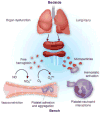Storage lesion: role of red blood cell breakdown
- PMID: 21496045
- PMCID: PMC3080238
- DOI: 10.1111/j.1537-2995.2011.03100.x
Storage lesion: role of red blood cell breakdown
Abstract
As stored blood ages intraerythrocytic energy sources are depleted resulting in reduced structural integrity of the membrane. Thus, stored red blood cells (RBCs) become less deformable and more fragile as they age. This fragility leads to release of cell-free hemoglobin (Hb) and formation of microparticles, submicron Hb-containing vesicles. Upon transfusion, it is likely that additional hemolysis and microparticle formation occurs due to breakdown of fragile RBCs. Release of cell-free Hb and microparticles leads to increased consumption of nitric oxide (NO), an important signaling molecule that modulates blood flow, and may promote inflammation. Stored blood may also be deficient in recently discovered blood NO synthase activity. We hypothesize that these factors play a potential role in the blood storage lesion.
© 2011 American Association of Blood Banks.
Conflict of interest statement
JL declares no conflict of interest.
Figures


References
-
- Dern RJ, Brewer GJ, Wiorkowski JJ. Studies on the preservation of human blood. II. The relationship of erythrocyte adenosine triphosphate levels and other in vitro measures to red cell storageability. J Lab Clin Med. 1967;69:968–78. - PubMed
-
- Beutler E, Kuhl W. Volume Control of Erythrocytes During Storage - the Role of Mannitol. Transfusion. 1988;28(4):353–7. - PubMed
-
- Latham JT, Bove JR, Weirich FL. Chemical and Hematologic Changes in Stored Cpda-1 Blood. Transfusion. 1982;22(2):158–9. - PubMed
-
- Greenwalt TJ, Sostok CZ, Dumaswala UJ. Studies in Red-Blood-Cell Preservation .2. Comparison of Vesicle Formation, Morphology, and Membrane-Lipids During Storage in as-1 and Cpda-1. Vox Sanguinis. 1990;58(2):90–3. - PubMed
Publication types
MeSH terms
Substances
Grants and funding
LinkOut - more resources
Full Text Sources
Other Literature Sources
Medical
Research Materials

